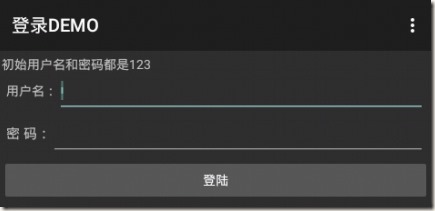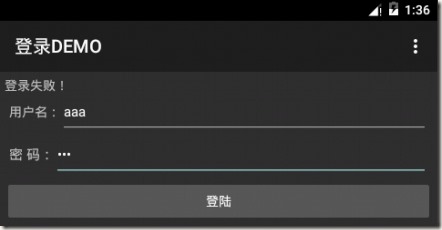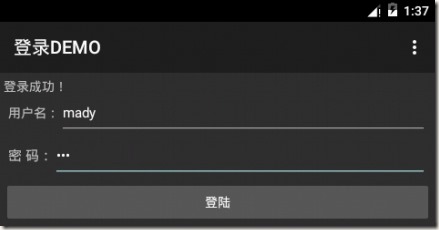做應用型的APP肯定是要和網路互動的,那麼本節就來實戰一把Android訪問網路API,還是使用上節的DEMO:
一、準備API:
一般都採用Json作為資料交換格式,目前各種語言均能輸出Json串。
假如使用PHP輸出一段簡單的Json,可以這麼寫:
<?php $arr = array ('users'=>array('mady','123')); echo json_encode($arr); ?>
輸出的Json如下:
{"users":["mady","123"]}
也可以使用VS建立一個API直接序列化一個陣列,或者其他任何方式只要資料格式正確就沒問題。
二、實現網路API訪問:
首先訪問網路需要授權,也就是安裝時提醒打對勾的那部分:
開啟Bin/res/AndroidManifest.xml在根節點下面加入一個授權申請節點:
<uses-permission android:name="android.permission.INTERNET"/>
然後是訪問網路,這裡有一段從網上來的訪問類:
import org.apache.http.HttpEntity; import org.apache.http.HttpResponse; import org.apache.http.HttpStatus; import org.apache.http.client.HttpClient; import org.apache.http.client.methods.HttpPost; import org.apache.http.impl.client.DefaultHttpClient; import org.apache.http.util.EntityUtils; public class HttpUtils { /** * @param path 請求的伺服器URL地址 * @param encode 編碼格式 * @return 將伺服器端返回的資料轉換成String */ public static String sendPostMessage(String path, String encode) { String result = ""; HttpClient httpClient = new DefaultHttpClient(); try { HttpPost httpPost = new HttpPost(path); HttpResponse httpResponse = httpClient.execute(httpPost); if(httpResponse.getStatusLine().getStatusCode() == HttpStatus.SC_OK) { HttpEntity httpEntity = httpResponse.getEntity(); if(httpEntity != null) { result = EntityUtils.toString(httpEntity, encode); } } } catch (Exception e) { e.printStackTrace(); } finally { httpClient.getConnectionManager().shutdown(); } return result; } }
還有一段從網上來的Json解析類,使用Android自帶的解析庫:
import java.util.ArrayList; import java.util.List; import org.json.JSONArray; import org.json.JSONObject; public class JsonUtil { /** * @param citiesString 從伺服器端得到的JSON字串資料 * @return 解析JSON字串資料,放入List當中 */ public static List<String> parseCities(String citiesString) { List<String> cities = new ArrayList<String>(); try { JSONObject jsonObject = new JSONObject(citiesString); JSONArray jsonArray = jsonObject.getJSONArray("users"); for(int i = 0; i < jsonArray.length(); i++) { cities.add(jsonArray.getString(i)); } } catch (Exception e) { e.printStackTrace(); } return cities; } }
最後需要注意的就是在Android中訪問網路必須是非同步方式,同步方式直接報錯,所以需要增加非同步訪問:
public class MyAsyncTask extends AsyncTask<String, Void, List<String>> { @Override protected void onPreExecute() { super.onPreExecute(); } @Override protected List<String> doInBackground(String... params) { List<String> cities = new ArrayList<String>(); String citiesString = HttpUtils.sendPostMessage(params[0], "utf-8"); cities = JsonUtil.parseCities(citiesString); return cities; } @Override protected void onPostExecute(List<String> result) { TextView lblInfo=(TextView)findViewById(R.id.form_title); EditText txt_login_name=(EditText)findViewById(R.id.txt_login_name); EditText txt_login_pass=(EditText)findViewById(R.id.txt_login_pwd); String loginName=txt_login_name.getText().toString().trim(); String loginPass=txt_login_pass.getText().toString().trim(); if(loginPass.equals(result.get(1))&&loginName.equals(result.get(0))) { lblInfo.setText("登入成功!"); } else { lblInfo.setText("登入失敗!"); } super.onPostExecute(result); } }
分為訪問前、訪問中、訪問後(估計是方便增加進度條),我們在訪問後增加處理程式碼即可,然後在上節的按鈕點選事件下呼叫:
private final String CITY_PATH_JSON = "http://192.168.1.6:89/Login2.php"; public void btn_click(View v) { new MyAsyncTask().execute(CITY_PATH_JSON); }
唯一需要的說明:訪問後的Result型別就是訪問中的返回值型別
唯二需要哦的說明:API必須架設在另外的機器上,而且必須使用IP訪問,因為localhost和127都被模擬器自己用了.
先看看登入的使用者名稱和密碼是什麼,訪問下API:
執行APP:
輸入正確的資訊:



